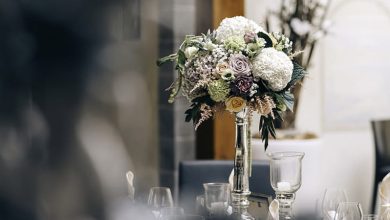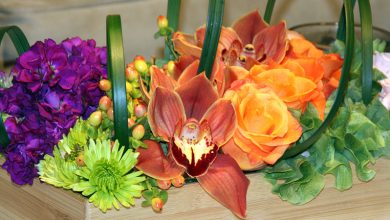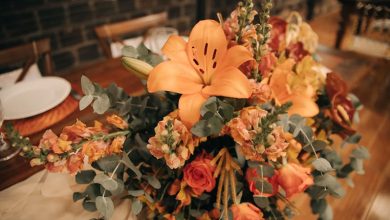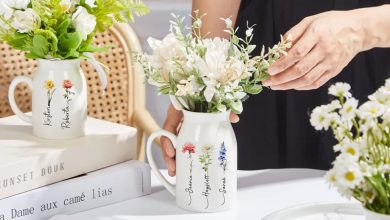How to Take Care of Hanging Flower Baskets?
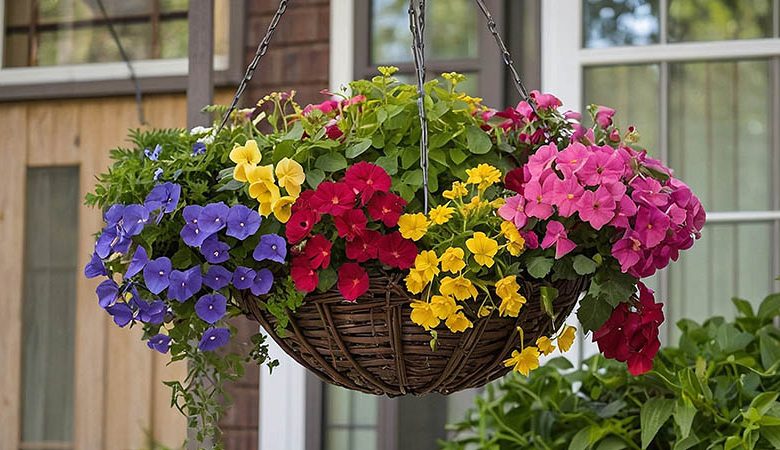
Hanging flower baskets are a beautiful addition to any outdoor space, adding color, texture, and a touch of nature to your home. To keep these stunning floral displays thriving, it’s essential to know how to take care of hanging flower baskets properly. This comprehensive guide will provide you with all the information you need to ensure your hanging flower baskets remain healthy and vibrant throughout the growing season.
Why Choose Hanging Flower Baskets?
Hanging flower baskets are a versatile and space-saving way to grow flowers. They are perfect for small gardens or areas with limited ground space.
Additionally, they allow you to create a lush, cascading effect with your plants, making a stunning visual impact. Hanging baskets also help keep plants out of reach of pests and provide better air circulation around the foliage.
Benefits of hanging flower baskets:
- Aesthetic Appeal: Hanging flower baskets add instant beauty to any outdoor area.
- Space Efficiency: They make use of vertical space, ideal for small gardens.
- Versatility: Suitable for a variety of plants, from flowers to herbs.
- Pest Control: Elevated position helps protect plants from ground-dwelling pests.
Choosing the Right Hanging Flower Baskets for Your Space
Selecting the perfect hanging baskets is essential to creating a beautiful and functional display. Understanding how to take care of hanging flower baskets starts with choosing the right type, material, and size that best suits your space and aesthetic preferences. This foundational step ensures that your baskets not only look great but also support healthy plant growth.
Types of Hanging Flower Baskets
There are several types of hanging flower baskets to choose from, each with its own advantages:
- Plastic Baskets: Lightweight and inexpensive, but may not be as durable.
- Metal Baskets: Sturdy and long-lasting, often with a decorative design.
- Wicker Baskets: Attractive and natural-looking, but may require more maintenance.
Material Considerations
When selecting a hanging flower basket, consider the material that best suits your needs and aesthetic preferences. Plastic baskets are practical and low-cost, while metal and wicker options provide a more classic look but might need additional care to prevent rust or rot.
Read More: Types of Hanging Flower Baskets for Different Tastes
Size and Weight Limitations
Ensure the size of the basket matches the space where you plan to hang it. Consider the weight of the basket when filled with soil and plants, and make sure the support structure can handle it. Larger baskets hold more soil, which retains moisture longer but will be heavier.
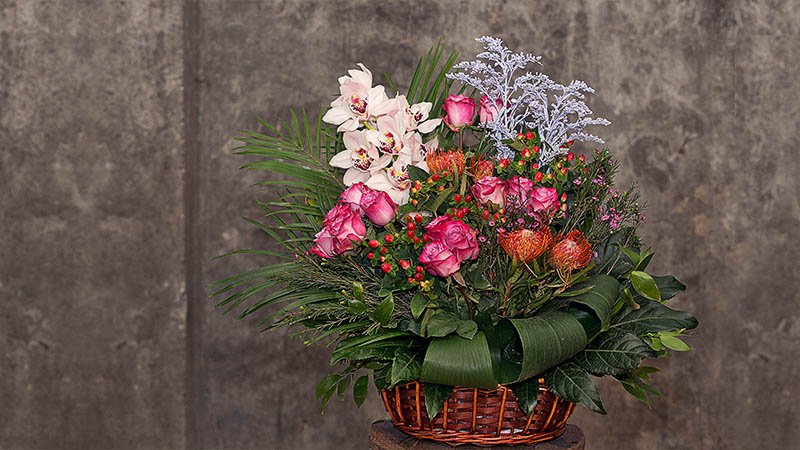
Selecting the Best Flowers for Hanging Baskets
Choosing the right flowers is the first step in learning how to take care of hanging flower baskets. Selecting a mix of annuals and perennials, as well as flowering and foliage plants, will create a vibrant and balanced display that lasts throughout the season.
Annuals vs. Perennials
When choosing flowers for your hanging baskets, decide between annuals, which bloom for one season, and perennials, which come back year after year.
Annuals like petunias, geraniums, and begonias are popular for their vibrant colors and long blooming periods. Perennials such as fuchsias and ivy provide lasting greenery and can be paired with annuals for continuous color.
Flowering Plants vs. Foliage Plants
Mixing flowering plants with foliage plants creates a visually appealing basket. Flowering plants add color, while foliage plants like ferns and trailing ivy provide texture and greenery. This combination enhances the overall look and longevity of your hanging basket.
Color and Design Considerations
Select flowers that complement each other in color and growth habit. Consider using a color scheme, such as monochromatic, analogous, or complementary colors, to create a cohesive design. Pay attention to the plant’s growth habits to ensure a balanced and aesthetically pleasing arrangement.
How to Plant Hanging Flower Baskets for Optimal Growth
Proper planting techniques are essential for ensuring the success of your hanging baskets. Knowing how to plant hanging flower baskets for optimal growth involves selecting the right soil, spacing the plants correctly, and arranging them to maximize visual appeal.
Choosing the Right Soil
Use high-quality potting soil that provides good drainage and aeration. Avoid garden soil, as it may be too heavy and compact for hanging baskets. Potting mixes with added perlite or vermiculite help retain moisture while ensuring proper drainage.
Planting Techniques
Start by filling the basket with soil, leaving a few inches at the top. Arrange the plants in the basket, starting with the center and working your way outwards. Gently remove the plants from their pots, loosen the roots, and place them in the soil. Fill in around the plants with more soil, pressing gently to eliminate air pockets.
Read More: Types of Artificial Flower Arrangements for Dining Table
Spacing and Arrangement Tips
Space the plants according to their mature size to avoid overcrowding. Allow enough room for each plant to grow and thrive. Consider the growth habit of each plant (upright, trailing, or mounding) to create a balanced and visually appealing arrangement.

How to Take Care of Hanging Flower Baskets: Watering Tips
Watering is a critical aspect of how to take care of hanging flower baskets. Understanding how often and how much to water will keep your plants healthy and prevent common issues like root rot or dehydration.
How Often to Water
Proper watering is crucial for the health of your hanging flower baskets. Watering needs vary depending on the type of plants, the size of the basket, and the weather conditions. In general, hanging baskets need to be watered daily, especially during hot, dry periods. Check the moisture level by sticking your finger into the soil; if it feels dry an inch below the surface, it’s time to water.
Signs of Overwatering and Underwatering
Overwatering can lead to root rot and other issues, while underwatering causes the plants to wilt and dry out. Signs of overwatering include yellowing leaves, a mushy texture, and mold growth. Underwatered plants will have dry, crispy leaves and drooping stems. Adjust your watering routine based on these signs to maintain the right moisture balance.
Read More: The Best Air Purifying House Plants Safe For Dogs
Best Practices for Watering Hanging Baskets
- Water in the Morning: Watering in the morning allows the plants to absorb moisture before the heat of the day.
- Water Thoroughly: Ensure water reaches the root zone by watering until it starts to drain from the bottom.
- Use a Watering Can with a Long Spout: This helps direct water to the base of the plants without disturbing the foliage.
Feeding Your Hanging Flower Baskets: Essential Nutrients
Feeding your plants with the right nutrients is vital for their growth and flowering. Knowing how to take care of hanging flower baskets includes understanding the types of fertilizers to use and how to apply them effectively.
Types of Fertilizers
Hanging flower baskets benefit from regular feeding to promote healthy growth and blooming. Choose a balanced, water-soluble fertilizer with equal parts nitrogen, phosphorus, and potassium (e.g., 10-10-10). Slow-release granular fertilizers are also an option for sustained feeding over time.
When and How to Apply Fertilizers
Feed your hanging baskets every two weeks during the growing season. Dilute the fertilizer according to the package instructions and apply it evenly to the soil. Avoid getting fertilizer on the foliage, as it can cause burning.
Read More: Introduction Flower Wall Backdrop Ideas
Natural vs. Synthetic Fertilizers
Both natural and synthetic fertilizers can be effective. Natural fertilizers, such as compost or fish emulsion, are eco-friendly and provide a slow release of nutrients. Synthetic fertilizers offer a quick nutrient boost but should be used carefully to avoid over-fertilization.
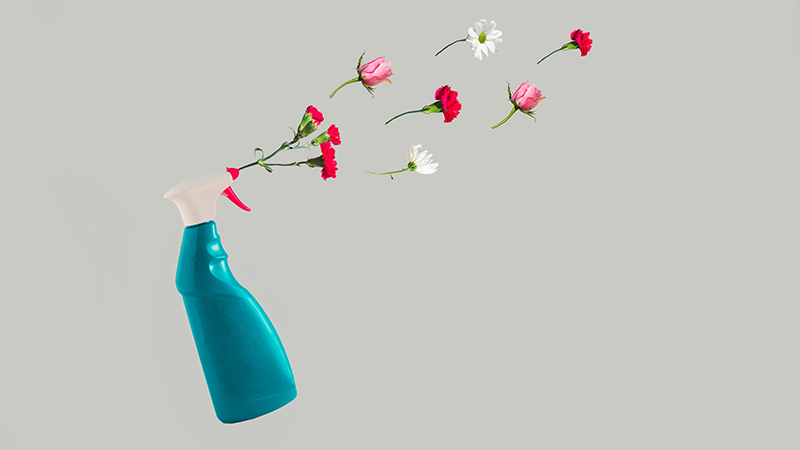
Light Requirements for Hanging Flower Baskets
Providing the appropriate amount of light is key to maintaining the health of your hanging baskets. Learning how to take care of hanging flower baskets means understanding the light needs of your plants and positioning your baskets accordingly.
Understanding Light Levels
Different plants have varying light requirements, so it’s essential to match the plants in your hanging basket to the available light conditions. Light levels are typically categorized as full sun, partial sun, partial shade, and full shade.
Best Locations for Hanging Baskets
Place hanging baskets in locations that receive the appropriate amount of light for the plants you have chosen. Full sun plants need at least 6 hours of direct sunlight, while shade-loving plants thrive in areas with filtered or indirect light.
Adjusting Light Exposure
If your hanging basket is not thriving, it may be due to inadequate light. Consider moving the basket to a different location or rotating it regularly to ensure even light exposure. If natural light is insufficient, you can supplement with grow lights.
Pruning and Deadheading for Healthy Hanging Flower Baskets
Regular pruning and deadheading are necessary to keep your hanging baskets looking their best. Knowing how to take care of hanging flower baskets includes learning the techniques for trimming back overgrown stems and removing spent flowers.
Why Pruning is Important
Pruning helps maintain the shape and health of your hanging flower baskets. It encourages new growth, prevents legginess, and improves air circulation. Regular pruning also helps manage the size of the plants and keeps them looking neat.
How to Prune and Deadhead Flowers
To prune, use sharp, clean scissors or pruning shears to remove dead, damaged, or overgrown stems. For deadheading, pinch or cut off spent flowers just above the first set of healthy leaves. This redirects the plant’s energy from seed production to new growth and blooming.
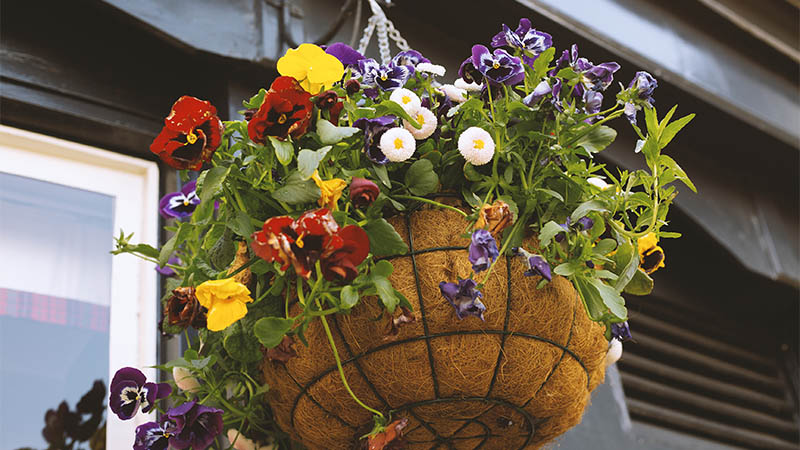
Tools Needed for Pruning
- Pruning Shears: Essential for cutting thicker stems and branches.
- Scissors: Suitable for delicate trimming and deadheading.
- Gloves: Protect your hands while working with plants.
Dealing with Pests and Diseases in Hanging Flower Baskets
Pests and diseases can quickly ruin the beauty of your hanging baskets. Understanding how to take care of hanging flower baskets involves identifying common problems and taking proactive measures to protect your plants.
Common Pests to Watch Out For
Hanging flower baskets can attract various pests, including aphids, spider mites, and whiteflies. Regularly inspect your plants for signs of pest activity, such as chewed leaves, sticky residue, or small insects.
Identifying and Treating Diseases
Common diseases affecting hanging baskets include powdery mildew, root rot, and fungal infections. Symptoms include discolored leaves, wilting, and mold growth. Treat diseases promptly by removing affected parts and applying appropriate fungicides or treatments.
Preventative Measures
- Good Air Circulation: Avoid overcrowding plants and ensure proper spacing.
- Clean Tools: Disinfect pruning tools between uses to prevent disease spread.
- Regular Inspection: Check plants regularly for early signs of pests or diseases.
Seasonal Care for Hanging Flower Baskets
Seasonal changes require different care strategies for your hanging baskets. Knowing how to take care of hanging flower baskets throughout the year will help you adapt to the changing needs of your plants as the seasons progress.
Spring Care Tips
- Inspect Baskets: Check for damage and repair or replace as needed.
- Refresh Soil: Add fresh potting mix and compost to replenish nutrients.
- Plant Selection: Choose spring-blooming plants and start planting early in the season.
Summer Maintenance
- Watering: Increase watering frequency during hot weather.
- Shade: Provide temporary shade during extreme heat to protect plants.
- Fertilizing: Continue regular feeding to support vigorous growth.
Fall and Winter Preparations
- Prune and Clean: Remove dead or damaged foliage and prune plants back.
- Move Indoors: Bring sensitive plants indoors to protect them from frost.
- Insulate: Wrap baskets with burlap or move them to sheltered locations.
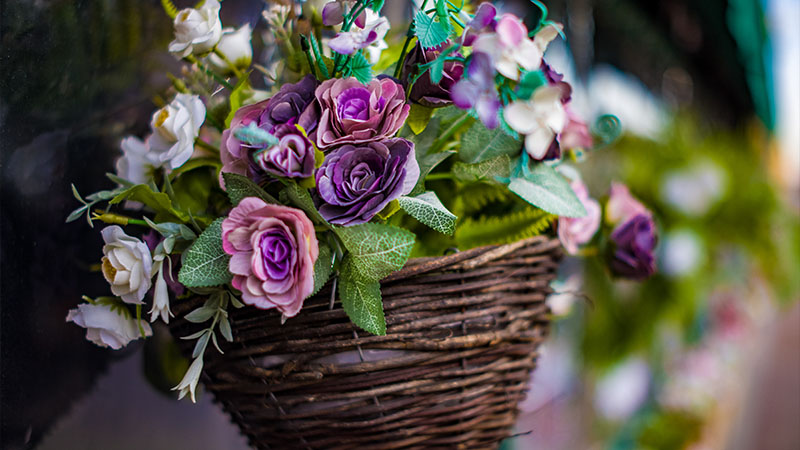
How to Refresh and Revitalize Tired Hanging Flower Baskets
Even the best-maintained hanging baskets can start to look tired over time. Learning how to take care of hanging flower baskets includes knowing when and how to refresh them by adding new plants, soil, or simply rearranging the existing ones.
Signs Your Basket Needs Refreshing
If your hanging basket looks tired and lacks vigor, it may be time to refresh it. Signs include sparse foliage, lack of blooms, and yellowing leaves.
Steps to Rejuvenate Your Baskets
- Remove Spent Plants: Take out any dead or dying plants.
- Add Fresh Soil: Top up with new potting mix and compost.
- Replant: Introduce new plants or cuttings to rejuvenate the basket.
Replacing Plants and Soil
Over time, the soil in hanging baskets can become compacted and depleted of nutrients. Consider repotting with fresh soil and new plants every season or as needed to maintain healthy growth.
Creative Ideas for Hanging Flower Baskets
Adding creativity to your hanging baskets can make them even more appealing. Knowing how to take care of hanging flower baskets creatively includes mixing different plant types, using vertical gardening techniques, and incorporating seasonal themes.
Mixing Different Plant Types
Combine trailing, upright, and mounding plants to create a dynamic and visually appealing hanging basket. Experiment with different textures, colors, and forms for a unique display.
Using Hanging Baskets for Vertical Gardening
Hanging baskets are perfect for vertical gardening, allowing you to maximize space and create a lush, green wall. Stack or stagger baskets to create layers of color and interest.
Seasonal and Holiday Themes
Change the plants in your hanging baskets to reflect different seasons or holidays. Use bright, warm colors for summer, and switch to cool tones or holiday-themed plants for winter.

Common Mistakes to Avoid When Caring for Hanging Flower Baskets
Avoiding common mistakes is crucial for the health of your hanging baskets. Understanding how to take care of hanging flower baskets involves recognizing and correcting errors such as overwatering, using the wrong soil, and ignoring light requirements.
Overwatering and Underwatering
One of the most common mistakes is improper watering. Avoid overwatering by checking the soil moisture before watering and ensuring proper drainage. Conversely, don’t let the soil dry out completely, as this can stress the plants.
Using the Wrong Soil
Garden soil is often too dense for hanging baskets and can lead to poor drainage and root rot. Always use a high-quality potting mix designed for container gardening.
Ignoring Light Requirements
Placing plants in the wrong light conditions can hinder their growth and blooming. Pay attention to the light requirements of each plant and position your baskets accordingly.
How to Take Care of Hanging Flower Baskets in Different Climates
Different climates present unique challenges for hanging baskets. Learning how to take care of hanging flower baskets in various weather conditions will help you adapt your care routine to ensure your plants thrive no matter where you live.
Caring for Baskets in Hot Climates
In hot climates, hanging baskets may dry out quickly. Water more frequently and consider using water-retentive crystals or mulch to retain moisture. Provide shade during the hottest part of the day to prevent sunburn.
Managing Baskets in Humid Environments
High humidity can promote fungal diseases. Ensure good air circulation around your hanging baskets and avoid overwatering. Use fungicides if necessary to control disease outbreaks.
Tips for Cooler Climates
In cooler climates, choose frost-resistant plants and provide protection from cold winds. Bring baskets indoors or to sheltered areas during frosty nights. Use insulating materials like burlap to protect roots from freezing temperatures.

Frequently Asked Questions About Hanging Flower Basket Care
Addressing common questions can help clarify the best practices for hanging basket maintenance. Knowing how to take care of hanging flower baskets includes understanding frequently asked questions about watering, fertilizing, pest control, and more.
How Often Should I Water My Hanging Basket?
Water your hanging baskets daily during the growing season, especially in hot, dry weather. Adjust the frequency based on the moisture level of the soil and the specific needs of the plants.
What Are the Best Flowers for Hanging Baskets?
Popular flowers for hanging baskets include petunias, fuchsias, geraniums, and begonias. Choose flowers that suit your local climate and light conditions for the best results.
How Can I Prevent Pests and Diseases?
Regularly inspect your hanging baskets for signs of pests and diseases. Maintain good air circulation, use clean tools, and apply appropriate treatments promptly to keep your plants healthy.
Final Thoughts
Knowing how to take care of hanging flower baskets is essential for maintaining their beauty and health throughout the season. With the right selection of plants, proper planting techniques, and consistent care, your hanging baskets will thrive and bring joy to your outdoor spaces.
Whether you’re a novice gardener or an experienced enthusiast, following these tips will help you create and maintain stunning floral displays that enhance your home and garden.


